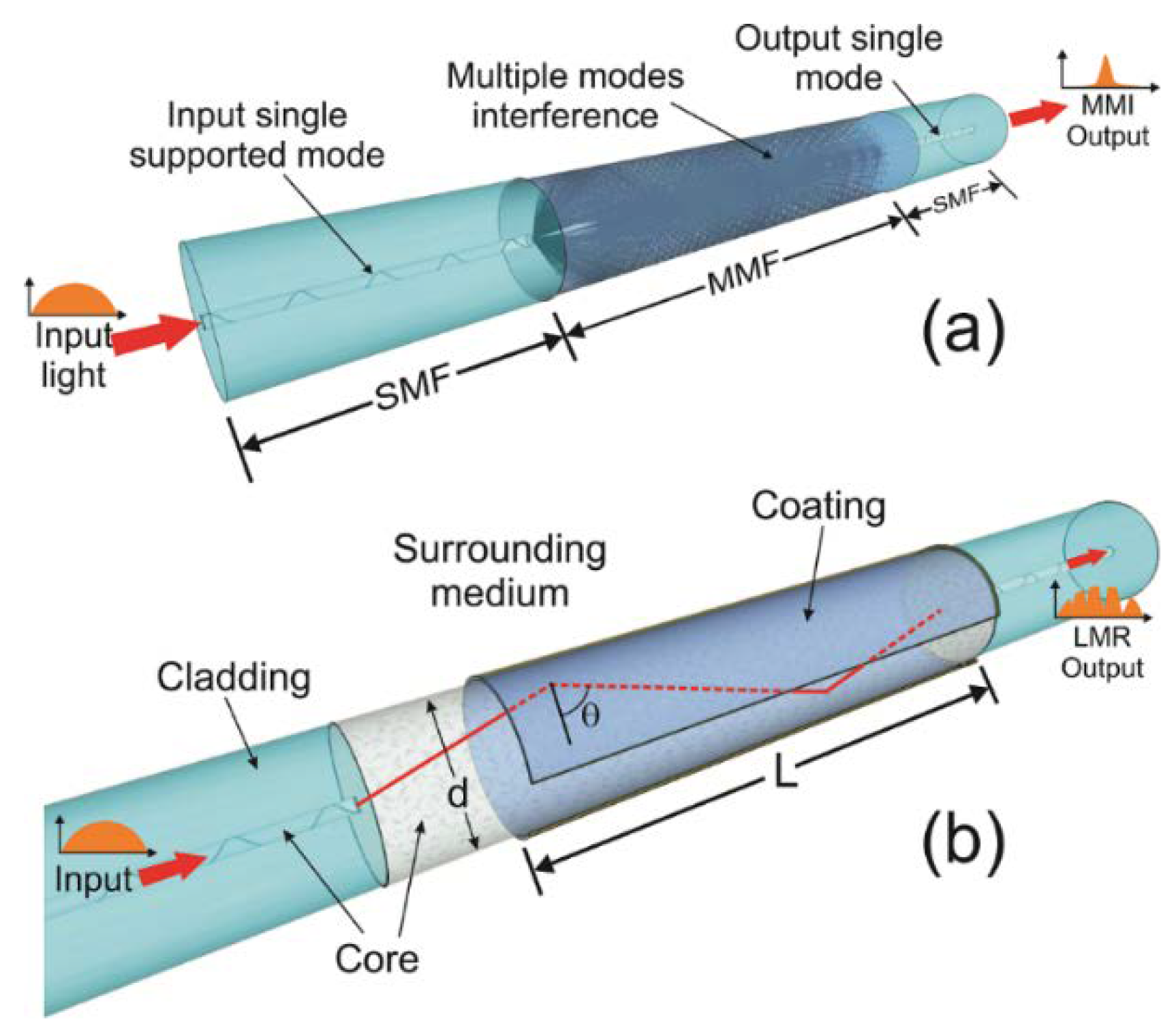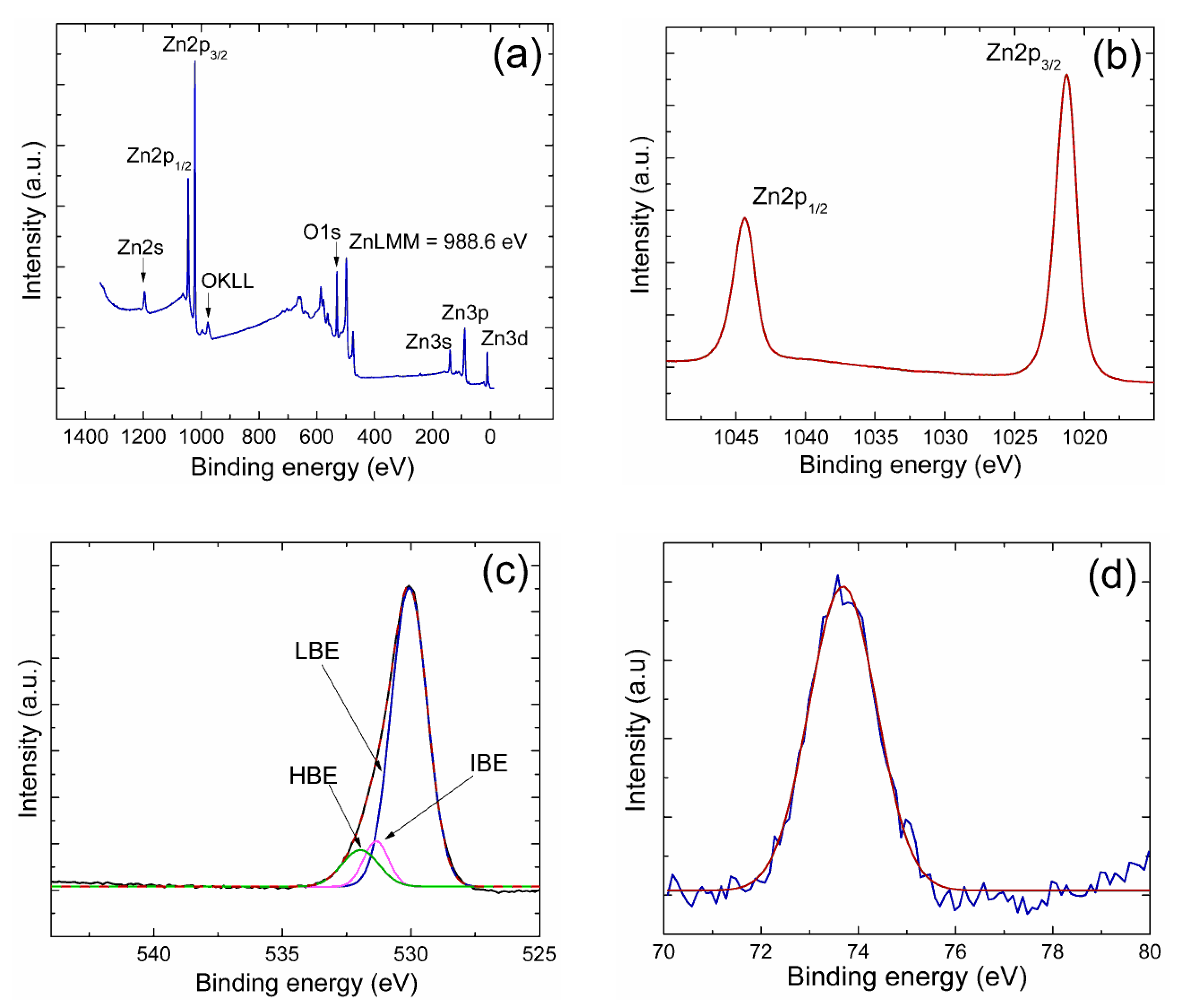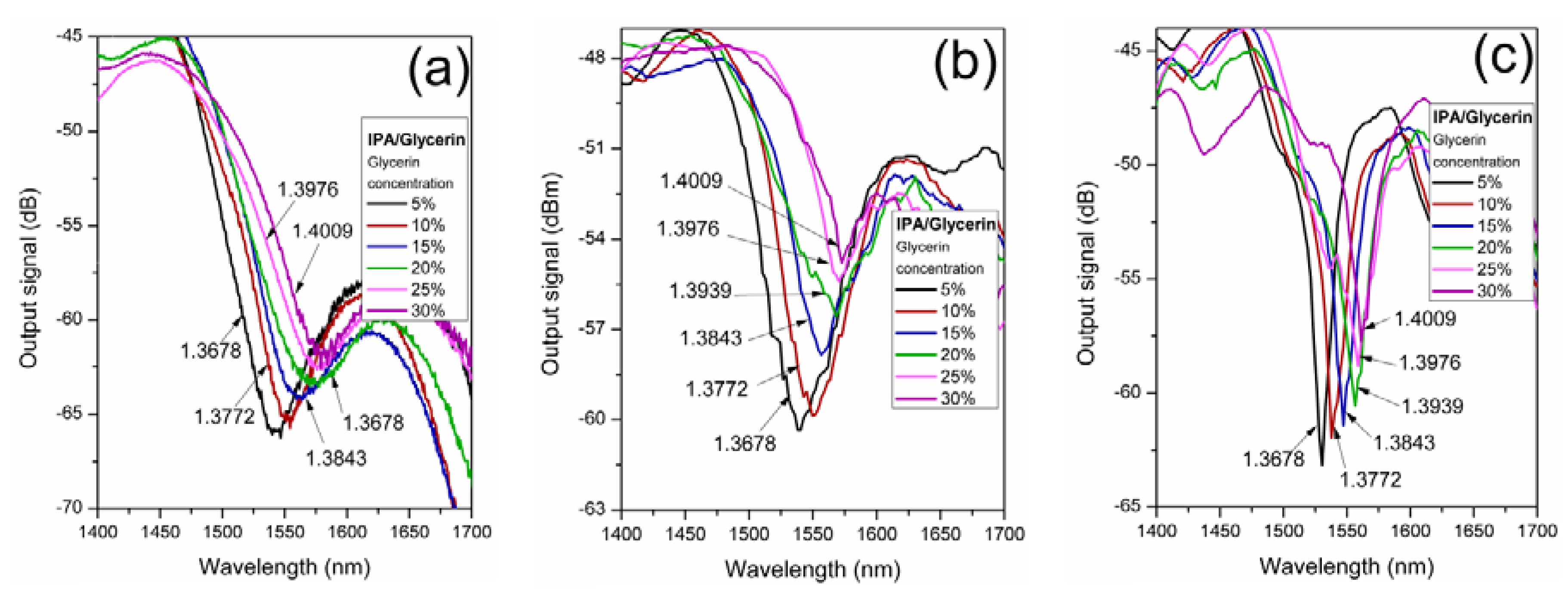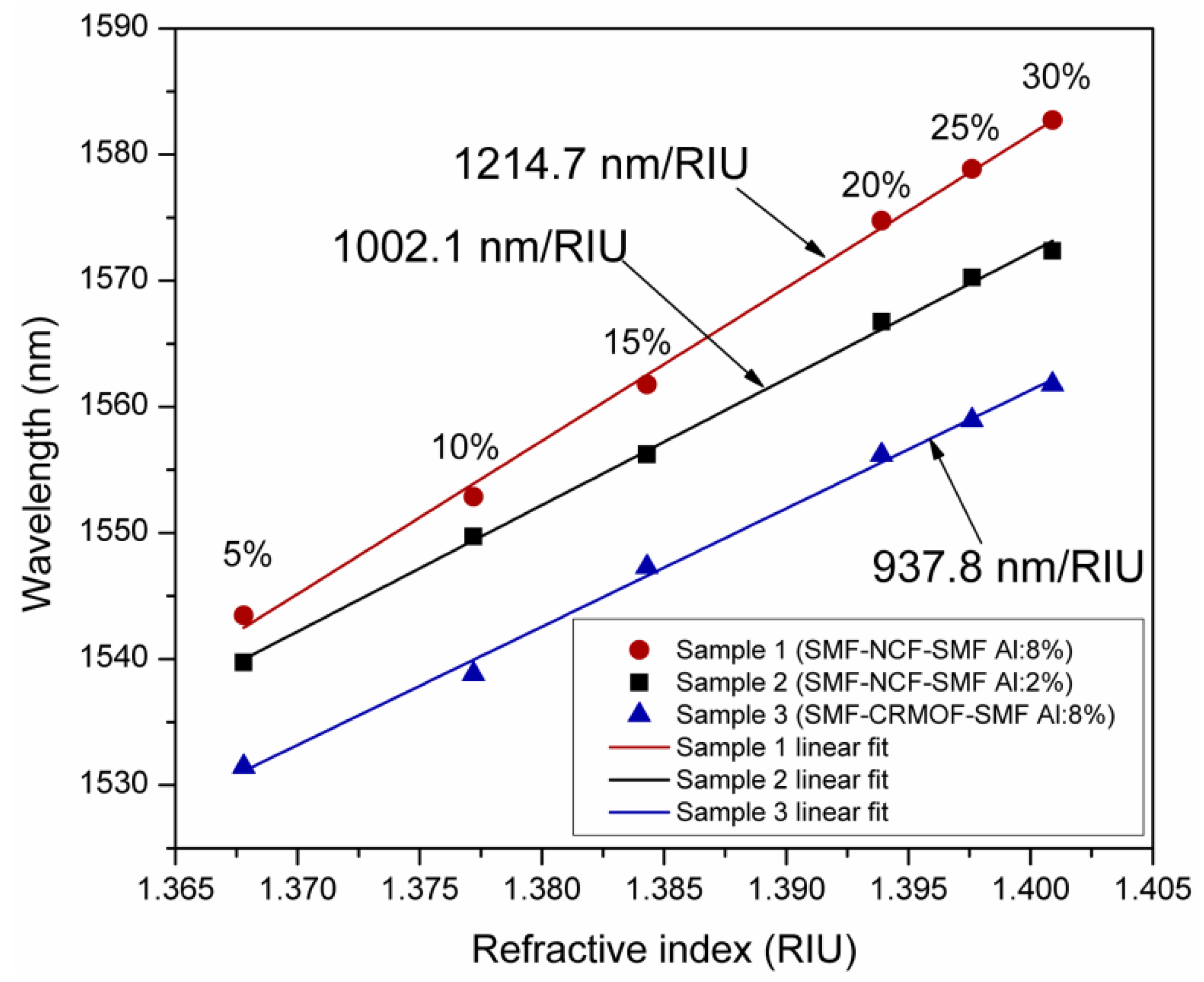Lossy Mode Resonance Generation on Sputtered Aluminum-Doped Zinc Oxide Thin Films Deposited on Multimode Optical Fiber Structures for Sensing Applications in the 1.55 µm Wavelength Range
Abstract
:1. Introduction
2. Thin Film Coated Fiber Structures for LMR-Based Sensors
2.1. Single-Mode–Multimode–Single-Mode Fiber Structures
2.2. LMR Generation in Thin Film Coated Optical Fibers.
3. Deposition of AZO Films on Fibers and Coating Characterization
4. Results and Discussion
5. Conclusions
Author Contributions
Funding
Acknowledgments
Conflicts of Interest
References
- Culshaw, B.; Kersey, A. Fiber-optic sensing: A historical perspective. J. Lightwave Technol. 2008, 26, 1064–1078. [Google Scholar] [CrossRef]
- Bogue, R. Fibre optic sensors: A review of today’s applications. Sens. Rev. 2011, 31, 304–309. [Google Scholar] [CrossRef]
- Sharma, A.K.; Jha, R.; Gupta, B.D. Fiber-optic sensors based on surface plasmon resonance: A comprehensive review. IEEE Sens. J. 2007, 7, 1118–1129. [Google Scholar] [CrossRef]
- Goswami, N.; Chauhan, K.K.; Saha, A. Analysis of surface plasmon resonance based bimetal coated tapered fiber optic sensor with enhanced sensitivity through radially polarized light. Opt. Commun. 2016, 379, 6–12. [Google Scholar] [CrossRef]
- Gandhi, M.S.A.; Chu, S.; Senthilnathan, K.; Babu, P.R.; Nakkeeran, K.; Li, Q. Recent advances in plasmonic sensor-based fiber optic probes for biological applications. Appl. Sci. 2019, 9, 949. [Google Scholar] [CrossRef]
- Usha, P.S.; Satyendra, K.M.; Gupta, B.D. Fiber optic hydrogen sulfide gas sensors utilizing ZnO thin film/ZnO nanoparticles: A comparison of surface plasmon resonance and lossy mode resonance. Sens. Actuators B Chem. 2015, 218, 196–204. [Google Scholar] [CrossRef]
- Del Villar, I.; Zamarreño, C.R.; Hernaez, M.; Arregui, F.J.; Matias, I.R. Lossy mode resonance generation with indium tin oxide coated optical fibers for sensing application. J. Lightwave Technol. 2010, 28, 111–117. [Google Scholar] [CrossRef]
- Arregui, F.J.; Del Villar, I.; Corres, J.M.; Goicoechea, J.; Zamarreño, C.R.; Elosua, C.; Hernaez, M.; Rivero, P.J.; Socorro, A.B.; Urrutia, A.; et al. Fiber-optic lossy mode resonance sensors. Procedia Eng. 2014, 87, 3–8. [Google Scholar] [CrossRef]
- Wang, Q.; Zhao, W.M. A comprehensive review of lossy mode resonance-based fiber optic sensors. Opt. Lasers Eng. 2017, 100, 47–60. [Google Scholar] [CrossRef]
- Del Villar, I.; Arregui, F.J.; Zamarreño, C.R.; Corres, J.M.; Bariain, C.; Goicoechea, J.; Elosua, C.; Hernaez, M.; Ribero, P.J.; Socorro, A.B.; et al. Optical sensors based on lossy-mode resonances. Sens. Actuators B Chem. 2016, 240, 174–185. [Google Scholar] [CrossRef]
- Paliwal, N.; John, J. Lossy mode resonance (LMR) based fiber optic sensors: A review. IEEE Sens. J. 2015, 15, 5361–5371. [Google Scholar] [CrossRef]
- Xie, Q.; Chen, Y.; Li, X.; Yin, Z.; Wang, L.; Geng, Y.; Hong, X. Characteristics of D-shaped photonic crystal fiber surface plasmon resonance sensors with different side-polished lengths. Appl. Opt. 2017, 56, 1550–1555. [Google Scholar] [CrossRef]
- Hasan, M.; Akter, S.; Rifat, A.; Rana, S.; Ali, S.; Hasan, M.R.; Akter, S.; Rifat, A.A.; Rana, S.; Ali, S. A highly sensitive gold-coated photonic crystal fiber biosensor based on surface plasmon resonance. Photonics 2017, 4, 18. [Google Scholar] [CrossRef]
- Zhao, J.; Cao, S.; Liao, C.; Wang, Y.; Wang, G.; Xu, X.; Fu, C.; Xu, G.; Lian, J.; Wang, Y. Surface plasmon resonance refractive sensor based on silver-coated side-polished fiber. Sens. Actuators B Chem. 2016, 230, 206–211. [Google Scholar] [CrossRef]
- Ozcariz, A.; Dominik, M.; Smietana, M.; Zamarreño, C.R.; Del Villar, I.; Arreguia, F.J. Lossy mode resonance optical sensors based on indium-gallium-zinc oxide thin film. Sens. Actuators A Phys. 2019, 290, 20–27. [Google Scholar] [CrossRef]
- Del Villar, I.; Zamarreño, C.R.; Hernaez, M.; Arregui, F.J.; Matias, I.R. Generation of lossy mode resonances with absorbing thin-films. J. Lightwave Technol. 2010, 28, 3351–3357. [Google Scholar] [CrossRef]
- Sanchez, P.; Zamarreño, C.R.; Hernaez, M.; Matias, R.I.; Arregui, F.J. Optical fiber refractometers based on lossy mode resonances by means of SnO2 sputtered coatings. Sens. Actuators B Chem. 2014, 202, 154–159. [Google Scholar] [CrossRef]
- Del Villar, I.; Zamarreño, C.R.; Hernaez, M.; Sanchez, P.; Arregui, F.J.; Matias, I.R. Generation of surface plasmon resonance and lossy mode resonance by thermal treatment of ITO thin-films. Opt. Laser Technol. 2015, 69, 1–7. [Google Scholar] [CrossRef]
- Zamarreño, C.R.; Hernáez, M.; Del Villar, I.; Matías, I.R.; Arregui, F.J. Optical fiber pH sensor based on lossy-mode resonances by means of thinpolymeric coatings. Sens. Actuators B Chem. 2011, 155, 290–297. [Google Scholar] [CrossRef]
- Arreguia, F.J.; Del Villar, I.; Zamarreño, C.R.; Zubiate, P.; Matias, I.R. Giant sensitivity of optical fiber sensors by means of lossy mode resonance. Sens. Actuators B Chem. 2014, 232, 660–665. [Google Scholar] [CrossRef]
- Zamarreño, C.R.; Zubiate, P.; Sagües, M.; Matias, I.R.; Arregui, F.J. Experimental demonstration of lossy mode resonance generation for transverse-magnetic and transverse-electric polarizations. Opt. Lett. 2013, 38, 2481–2483. [Google Scholar] [CrossRef] [PubMed]
- Xia, Y.P.; Wang, P.H.; Shi, S.W.; Liu, Y.M.; He, G.; Zhang, M.; Lü, J.G.; Sun, Z.Q. Deposition and characterization of AZO thin films on flexible glass substrates using DC magnetron sputtering technique. Ceram. Int. 2016, 43, 4536–4544. [Google Scholar] [CrossRef]
- Fullager, D.B.; Boreman, G.D.; Ellinger, C.D.; Hofmann, T. Broadband optical properties of aluminium zinc oxide thin films prepared by spatial atomic layer deposition. Thin Solid Films 2018, 653, 267–273. [Google Scholar] [CrossRef] [Green Version]
- Vinoth, E.; Gowrishankar, S.; Gopalakrishnan, N. Effect of Mg doping in the gas-sensing performance of RF-sputtered ZnO thin films. Appl. Phys. A 2018, 124, 433. [Google Scholar] [CrossRef]
- Wang, H.; Sun, Y.; Chen, J.; Fang, L.; Wang, L.; Ye, L.; Li, W. High performance AZO thin films deposited by RF magnetron sputtering at low temperature. Recent Pat. Mater. Sci. 2015, 8, 260–264. [Google Scholar] [CrossRef]
- Prieto-Cortés, P.; Álvarez-Tamayo, R.I.; García-Méndez, M.; Durán-Sánchez, M.; Barcelata-Pinzón, A.; Ibarra-Escamilla, B. Magnetron sputtered Al-doped ZnO thin film as saturable absorber for passively Q-switched Er/Yb double clad fiber laser. Laser Phys. Lett. 2019, 16, 045101. [Google Scholar] [CrossRef]
- Ozcariz, A.; Piña-Azamar, D.A.; Zamarreño, C.R.; Dominguez, R.; Arregui, F.J. Aluminum doped zinc oxide (AZO) coated optical fiber LMR refractometers—An experimental demonstration. Sens. Actuators B Chem. 2019, 281, 698–704. [Google Scholar] [CrossRef]
- Subramanyam, T.K.; Goutham, P.; Kumar, S.P.; Yadhuraj, S.R.; Geetha, K.S. Optimization of sputtered AZO thin films for device application. Mater. Today Proc. 2018, 5, 10851–10859. [Google Scholar] [CrossRef]
- Verma, R.K. Sensitivity enhancement of a lossy mode resonance based tapered fiber optic sensor with an optimum taper profile. J. Phys. D Appl. Phys. 2018, 51, 415302. [Google Scholar]
- El-Sherif, M.; Bansal, L.; Yuan, J. Fiber optic sensors for detection of toxic and biological threats. Sensors 2007, 7, 3100–3118. [Google Scholar] [CrossRef]
- Álvarez-Tamayo, R.I.; Aguilar-Soto, J.G.; Durán-Sánchez, M.; Antonio-López, J.E.; Ibarra-Escamilla, B.; Kuzin, E.A. MMI filters configuration for dual-wavelength generation in a ring cavity erbium-doped fibre laser. J. Eur. Opt. Soc. Rapid Publ. 2016, 12, 20. [Google Scholar] [CrossRef] [Green Version]
- Del Villar, I.; Socorro, A.B.; Corres, J.M.; Arregui, F.J.; Matias, I.R. Optimization of sensors based on multimode interference in single-mode–multimode–single-mode structure. J. Lightwave Technol. 2013, 31, 3460–3468. [Google Scholar] [CrossRef]
- Del Villar, I.; Hernaez, M.; Zamarreño, C.R.; Sánchez, P.; Fernández-Valdivielso, C.; Arregui, F.J.; Matias, I.R. Design rules for lossy mode resonance based sensors. Appl. Opt. 2012, 51, 4298–4307. [Google Scholar] [CrossRef] [PubMed]
- Del Villar, I.; Zamarreño, C.R.; Sanchez, P.; Hernaez, M.; Valdivielso, C.F.; Arregui, F.J.; Matias, I.R. Generation of lossy mode resonances by deposition of high-refractive-index coatings on uncladded multimode optical fibers. J. Opt. 2010, 12, 095503. [Google Scholar] [CrossRef]
- Dwivedi, Y.S.; Sharma, A.K.; Gupta, B.D. Influence of skew rays on the sensitivity and signal-to-noise ratio of a fiber-optic surface-plasmon-resonance sensor: A theoretical study. Appl. Opt. 2007, 46, 4563–4569. [Google Scholar] [CrossRef] [PubMed]
- Paliwal, N.; John, J. Sensitivity Enhancement of Aluminium Doped Zinc Oxide (AZO) Coated Lossy Mode Resonance (LMR) Fiber Optic Sensors Using Additional Layer of Oxides. In Proceedings of the Frontiers in Optics 2014, Tucson, AZ, USA, 19–23 October 2014. [Google Scholar]
- Thermo Scientific XPS Database. Available online: https://xpssimplified.com (accessed on 15 July 2019).
- Al-Kuhaili, M.F.; Durrani, S.M.A.; Bakhtiari, I.A.; Saleem, M. Optical constants of vacuum annealed radio frequency (RF) magnetron sputtered zinc oxide thin films. Opt. Commun. 2012, 285, 4405–4412. [Google Scholar] [CrossRef]
- Kim, Y.; Lee, W.; Jung, D.R.; Kim, J.; Nam, S.; Kim, H.; Park, B. Optical and electronical properties of post-annealed ZnO:Al thin film. Appl. Phys. Lett. 2010, 96, 171902. [Google Scholar] [CrossRef]
- Han, S.I.; Kim, H.B. A Study on Properties of RF-sputtered Al-doped ZnO Thin Films Prepared with Different Ar Gas Flow Rates. Appl. Sci. Converg. Technol. 2016, 25, 145–148. [Google Scholar] [CrossRef] [Green Version]
- García-Méndez, M.; Bedoya-Calle, A.; Rangel-Segura, R.; Coello, V. Investigation of the annealing effects on the structural and opto-electronical properties of RF-sputtered ZnO films studied by the Drude-Lorentz model. Appl. Phys. A Mater. Sci. Process. 2015, 120–124, 1375–1382. [Google Scholar] [CrossRef]
- Jang, J.S.; Kim, J.; Suryawanshi, M.P.; Lokhande, A.C.; Shin, H.H.; Lee, D.S.; Kim, J.H. Effect of radio frequency power on the properties of Al-doped ZnO (AZO) thin films and their application to Cu2ZnSn(S,Se)4 thin-film solar cells. J. Nanoelectron. Optoelectron. 2018, 13, 1689–1694. [Google Scholar] [CrossRef]






| Sample | Target (% at. Conc.) | Fiber Structure | Thickness (nm) |
|---|---|---|---|
| 1 | Zn:Al, 92:8% | SMF–NCF–SMF | 110 |
| 2 | Zn:Al, 98:2% | SMF–NCF–SMF | 160 |
| 3 | Zn:Al, 98:2% | SMF–CRMOF–SMF | 150 |
| Sample | Empirical Formulae | Eg (eV) |
|---|---|---|
| 1 | Zn0.30:O0.59:Al0.09 | 3.51 |
| 2 | Zn0.32:O0.60:Al0.07 | 3.51 |
| 3 | Zn0.32:O0.60:Al0.07 | 3.41 |
© 2019 by the authors. Licensee MDPI, Basel, Switzerland. This article is an open access article distributed under the terms and conditions of the Creative Commons Attribution (CC BY) license (http://creativecommons.org/licenses/by/4.0/).
Share and Cite
Prieto-Cortés, P.; Álvarez-Tamayo, R.I.; García-Méndez, M.; Durán-Sánchez, M. Lossy Mode Resonance Generation on Sputtered Aluminum-Doped Zinc Oxide Thin Films Deposited on Multimode Optical Fiber Structures for Sensing Applications in the 1.55 µm Wavelength Range. Sensors 2019, 19, 4189. https://doi.org/10.3390/s19194189
Prieto-Cortés P, Álvarez-Tamayo RI, García-Méndez M, Durán-Sánchez M. Lossy Mode Resonance Generation on Sputtered Aluminum-Doped Zinc Oxide Thin Films Deposited on Multimode Optical Fiber Structures for Sensing Applications in the 1.55 µm Wavelength Range. Sensors. 2019; 19(19):4189. https://doi.org/10.3390/s19194189
Chicago/Turabian StylePrieto-Cortés, Patricia, Ricardo I. Álvarez-Tamayo, Manuel García-Méndez, and Manuel Durán-Sánchez. 2019. "Lossy Mode Resonance Generation on Sputtered Aluminum-Doped Zinc Oxide Thin Films Deposited on Multimode Optical Fiber Structures for Sensing Applications in the 1.55 µm Wavelength Range" Sensors 19, no. 19: 4189. https://doi.org/10.3390/s19194189





